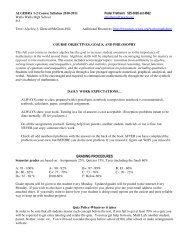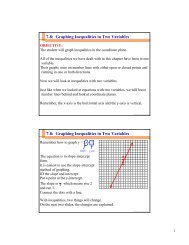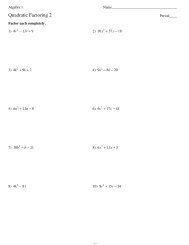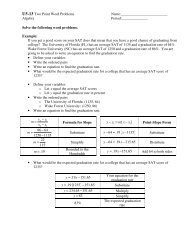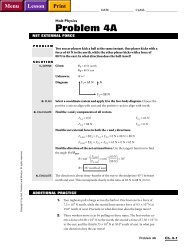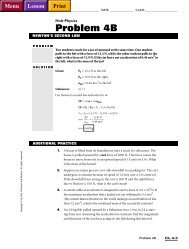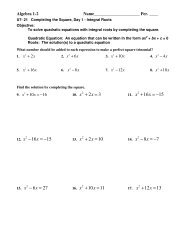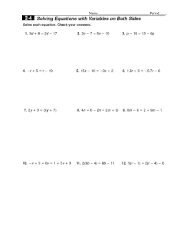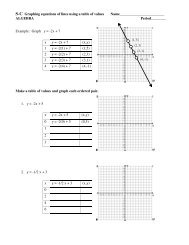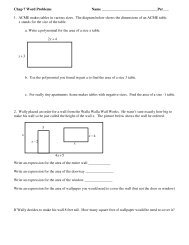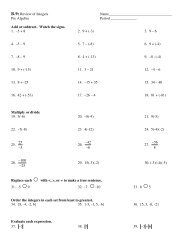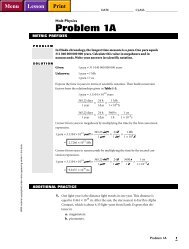Problem 4D
Problem 4D
Problem 4D
You also want an ePaper? Increase the reach of your titles
YUMPU automatically turns print PDFs into web optimized ePapers that Google loves.
Copyright © by Holt, Rinehart and Winston. All rights reserved.<br />
NAME ______________________________________ DATE _______________ CLASS ____________________<br />
Holt Physics<br />
<strong>Problem</strong> <strong>4D</strong><br />
FINAL VELOCITY AFTER ANY DISPLACEMENT<br />
PROBLEM<br />
SOLUTION<br />
1. DEFINE<br />
2. PLAN<br />
3. CALCULATE<br />
4. EVALUATE<br />
A bicyclist riding in the rain suddenly applies the brakes and slides to a<br />
stop. If the acceleration is −9.5 m/s 2 , what is the coefficient of kinetic friction<br />
between the bicycle’s rubber tires and the wet concrete?<br />
Given: a net =−9.5 m/s 2<br />
Unknown: m k = ?<br />
ADDITIONAL PRACTICE<br />
g = 9.81 m/s 2<br />
Choose the equation(s) or situation: Use Newton’s second law to describe the<br />
forces acting on the bicycle.<br />
F net = m a net =−F k<br />
Use the definition of frictional force to express F k in terms of the coefficient of<br />
friction.<br />
F k = m k F n = m k (mg)<br />
Rearrange the equation(s) to isolate the unknown(s):<br />
m anet =−mkmg mk = − ⎯ anet ⎯<br />
g<br />
Substitute the values into the equation(s) and solve:<br />
mk = ⎯ −( −9.5<br />
m/<br />
s<br />
2<br />
9.81<br />
m/s<br />
2 )<br />
⎯<br />
m k =<br />
0.97<br />
The coefficient of static friction for rubber and most surfaces is high. This is indicated<br />
by the value for rubber and wet concrete. Even under these conditions, m s is<br />
nearly 1.<br />
1. Blocks of ice are slid down a metal chute with an incline of 12.0° above<br />
the horizontal. The blocks undergo a constant acceleration of 1.22 m/s 2 .<br />
What is the coefficient of kinetic friction between the ice and the chute?<br />
2. A force of 1760 N is required to start moving a bundle of wooden<br />
planks up a ramp. If the ramp’s incline is 17° and the mass of the<br />
planks is 266 kg, what is the coefficient of static friction between the<br />
planks and the ramp?<br />
<strong>Problem</strong> <strong>4D</strong> Ch. 4–7
NAME ______________________________________ DATE _______________ CLASS ____________________<br />
Ch. 4–8<br />
3. A bundle of bricks is pulled up a ramp to a construction site. The bundle<br />
has a mass of 5.1 × 10 2 kg, and the incline of the ramp is 14°. If the<br />
minimum force needed to move the bricks up the ramp is 4.1 × 10 3 N,<br />
what is the coefficient of static friction between the bricks and the<br />
ramp?<br />
4. A force of 5.00 N to the left causes a 1.35 kg book to have a net acceleration<br />
of 0.76 m/s 2 to the left. What is the frictional force acting on the<br />
book?<br />
5. A jar is slid horizontally across a smooth table. If the coefficient of kinetic<br />
friction between the jar and the table is 0.20, what is the magnitude<br />
of the jar’s acceleration?<br />
6. A skier is pulled by an applied force of 2.50 × 10 2 N up a slope with an<br />
incline of 18.0°. If the combined mass of the skier and skis is 65.0 kg<br />
and the net acceleration uphill is 0.44 m/s 2 , what is the frictional force<br />
between the skis and the snow?<br />
7. If the skier in problem 6 skis down the same hill, what will the skier’s<br />
acceleration be?<br />
8. A crate is pushed across a level floor by a force of 3.00 × 10 2 N exerted<br />
at an angle of 20.0° below the horizontal. The coefficient of kinetic<br />
friction between the crate and floor is 0.250. If the crate’s velocity is<br />
constant, what is the magnitude of the normal force exerted on the<br />
crate by the floor? What is the mass of the crate?<br />
9. A horse must exert a force of 590 N just to keep a sleigh from sliding<br />
down a snowcovered hill. The component of the sleigh’s weight down<br />
the slope of the hill is 950 N, and the coefficient of static friction between<br />
the sleigh’s runners and the snow is 0.095. What is the normal<br />
force exerted by the ground on the sleigh? What is the sleigh’s mass if<br />
the slope of the hill is 14.0°?<br />
10. A freight elevator accelerates upward at 1.20 m/s 2 . A crate is lifted inside<br />
the elevator. In order to move the crate along the floor of the elevator,<br />
a worker must exert a force of 1.50 × 10 3 N at an angle of 10.0°<br />
below the horizontal on the upper corner of the crate. If the coefficient<br />
of static friction is 0.650, what is the normal force that the elevator<br />
floor exerts on the crate? What is the crate’s mass?<br />
Holt Physics <strong>Problem</strong> Bank<br />
Copyright © by Holt, Rinehart and Winston. All rights reserved.
V<br />
Additional Practice <strong>4D</strong><br />
Givens Solutions<br />
V Ch. 4–6<br />
1. a net = 1.22 m/s 2<br />
q = 12.0°<br />
g = 9.81 m/s 2<br />
2. Fapplied = 1760 N<br />
q = 17.0°<br />
m = 266 kg<br />
g = 9.81 m/s 2<br />
3. m = 5.1 × 10 2 kg<br />
q = 14°<br />
Fapplied = 4.1 × 10 3 N<br />
g = 9.81 m/s 2<br />
4. Fapplied = 5.0 N to the left<br />
m = 1.35 kg<br />
anet = 0.76 m/s 2 to the left<br />
5. mk = 0.20<br />
g = 9.81 m/s 2<br />
Holt Physics Solution Manual<br />
F net = m a net = mg(sin q) − F k<br />
Fk = mk Fn = mk mg(cos q)<br />
m anet + mk mg(cos q) = mg(sin q)<br />
mk = ⎯ g(sin<br />
q)<br />
− anet<br />
⎯ = =<br />
g (cos<br />
q)<br />
0.82 m/s<br />
mk = = 0.085<br />
2<br />
⎯⎯⎯<br />
(9.81 m/s 2 (9.81 m/s<br />
)(cos 12.0°)<br />
2 )(sin 12.0°) − 1.22 m/s 2<br />
⎯⎯⎯⎯<br />
(9.81 m/s 2 )(cos 12.0°)<br />
Fnet = Fapplied − mg(sin q) − Fs,max = 0<br />
Fs,max = ms Fn = ms mg(cos q)<br />
ms mg(cos q) = Fapplied − mg(sin q)<br />
ms = ⎯ Fapplied<br />
− mg(sin<br />
q)<br />
⎯ =<br />
mg(cos<br />
q)<br />
1760 − (266 kg)(9.81 m/s2 )(sin 17°)<br />
⎯⎯⎯⎯<br />
(266 kg)(9.81 m/s 2 )(cos 17°)<br />
1760 − 760 N<br />
ms = ⎯⎯⎯ =<br />
(266 kg)(9.81 m/s 2 )(cos 17°)<br />
m s = 0.40<br />
1.00 × 10 3 N<br />
⎯⎯⎯<br />
(266 kg)(9.81 m/s 2 )(cos 17°)<br />
2.04 m/s 2 − 1.22 m/s 2<br />
⎯⎯⎯<br />
(9.81 m/s 2 )(cos 12.0°)<br />
Fnet = Fapplied − mg(sin q) − Fs,max = 0<br />
Fs,max = ms Fn = ms mg(cos q)<br />
ms mg(cos q) = Fapplied − mg(sin q)<br />
ms = ⎯ Fapplied<br />
− mg(sin<br />
q) 4.1 × 10<br />
⎯ =<br />
mg(cos<br />
q)<br />
3 N − (5.1 × 10 2 kg)(9.81 m/s 2 )(sin 14°)<br />
⎯⎯⎯⎯⎯<br />
(5.1 × 10 2 kg)(9.81 m/s 2 )(cos 14°)<br />
4.1 × 10<br />
ms = =<br />
3 N − 1.2 × 10 3 N<br />
⎯⎯⎯⎯<br />
(5.1 × 10 2 kg)(9.81 m/s 2 )(cos 14°)<br />
m s = 0.60<br />
F net = m a net = F applied − F k<br />
Fk = Fapplied − m anet Fk = 5.0 N − (1.35 kg)(0.76 m/s 2 ) = 5.0 N − 1.0 N = 4.0 N<br />
Fk = 4.0 N to the right<br />
Fnet = m anet = Fk Fk = mkFh = mkmg anet = ⎯ mkmg ⎯ = mkg = (0.20)(9.81 m/s<br />
m<br />
2 )<br />
anet = 2.0 m/s 2<br />
2.9 × 10 3 N<br />
⎯⎯⎯⎯<br />
(5.1 × 10 2 kg)(9.81 m/s 2 )(cos 14°)<br />
Copyright © by Holt, Rinehart and Winston. All rights reserved.
Copyright © by Holt, Rinehart and Winston. All rights reserved.<br />
Givens Solutions<br />
6. Fapplied = 2.50 × 10 2 N<br />
m = 65.0 kg<br />
q = 18.0°<br />
anet = 0.44 m/s 2<br />
7. m = 65.0 kg<br />
g = 9.81 m/s 2<br />
Fk = 24 N<br />
q = 18.0°<br />
8. F applied = 3.00 × 10 2 N<br />
q = 20.0°<br />
mk = 0.250<br />
9. Fapplied = 590 N<br />
Fdownhill = 950 N<br />
ms = 0.095<br />
q = 14.0°<br />
10. a net = 1.20 m/s 2<br />
Fapplied = 1.50 × 10 3 N<br />
q =−10.0°<br />
ms = 0.650<br />
g = 9.81 m/s 2<br />
F net = m a net = F applied − mg(sin q) − F k<br />
F k = F applied − mg(sin q) − ma net<br />
Fk = 2.50 × 10 2 N − (65.0 kg)(9.81 m/s 2 )(sin 18.0°) − (65.0 kg)(0.44 m/s 2 )<br />
Fk = 2.50 × 10 2 N − 197 N − 29 N = 24 N = 24 N downhill<br />
Fnet = m anet = mg(sin q) − Fk anet = g(sin q) − ⎯ Fk<br />
⎯ = (9.81 m/s<br />
m<br />
2 24<br />
N<br />
)(sin 18.0°) − ⎯⎯ = 3.03 m/s<br />
65.0<br />
kg<br />
2 − 0.37 m/s 2 = 2.66 m/s 2<br />
a net = 2.66 m/s 2 downhill<br />
Fx,net = Fapplied(cos q) − Fk = 0<br />
Fy,net = Fn − mg + Fapplied(sin q) = 0<br />
F k = m kF n<br />
Fn = ⎯ Fapplied(<br />
cos q) (3.00 × 10<br />
⎯ = = 1130 N<br />
mk<br />
2 N)[cos(−20.0°)]<br />
⎯⎯⎯<br />
0.25°<br />
m = ⎯ Fn + Fapplied(sin q)<br />
⎯ =<br />
g<br />
m = ⎯ 1130<br />
N − 103N<br />
1030N<br />
⎯ 2 = ⎯<br />
9.81<br />
m/s<br />
9. 81<br />
m/s<br />
2<br />
1130 N + (3.00 × 10<br />
⎯ = 105 kg<br />
2 N)[sin(−20.0°)]<br />
⎯⎯⎯⎯<br />
9.81 m/s 2<br />
Fnet = Fapplied + Fs,max − Fdownhill = 0<br />
Fs,max = ms Fn = ms mg(cos q)<br />
ms Fn = Fdownhill − Fapplied Fn = ⎯ Fdownhill − Fapplied 950 N − 590<br />
N<br />
⎯ = ⎯⎯ = ⎯<br />
ms<br />
0.095<br />
360<br />
N<br />
⎯ = 3800 N<br />
0.095<br />
Fn =<br />
Fn<br />
m = ⎯⎯ = = 4.0 × 10<br />
g(cos<br />
q)<br />
2 3800 N<br />
⎯⎯⎯<br />
kg<br />
(9.81 m/s 2 3800 N perpendicular to and up from the ground<br />
)(cos 14.0°)<br />
Fx,net = Fapplied(cos q) − Fs,max = 0<br />
Fs,max = msFn Fn = ⎯ Fapplied(<br />
cos q)<br />
⎯ = = 2.27 × 10<br />
ms<br />
3 N<br />
Fn = 2.27 × 10 3 (1.50 × 10<br />
N, upward<br />
3 N)[cos(−10.0°)]<br />
⎯⎯⎯<br />
0.650<br />
F y,net = m a net = F n − mg + F applied(sin q)<br />
m(anet + g) = Fn + Fapplied(sin q)<br />
m = ⎯ Fn + Fapplied(<br />
sin q) 2.27 × 10<br />
⎯ =<br />
anet<br />
+ g<br />
3 N + (1.50 × 10 3 N)[sin(−10.0°)]<br />
⎯⎯⎯⎯⎯<br />
1.20 m/s 2 + 9.81 m/s 2<br />
m = = ⎯ 2<br />
2.27 × 10 3<br />
.01<br />
× 10<br />
N<br />
⎯ 2 = 183 kg<br />
11.01<br />
m/<br />
s<br />
3 N − 2.60 × 10 2 N<br />
⎯⎯⎯<br />
11.01 m/s 2<br />
Section Five—Solution Manual V Ch. 4–7<br />
V




